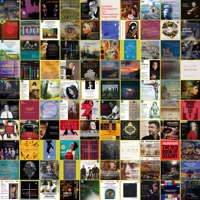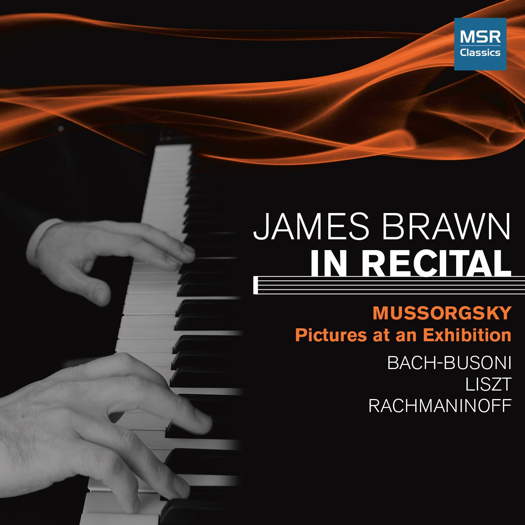 UPDATES: There's a new feature every day at Classical Music Daily. Read about the various ways we can keep in touch with you about what's happening here.
UPDATES: There's a new feature every day at Classical Music Daily. Read about the various ways we can keep in touch with you about what's happening here.
 SPONSORED: CD Spotlight. True Command - James Brawn plays Bach, Liszt, Musorgsky and Rachmaninov - recommended by Andrew Schartmann.
SPONSORED: CD Spotlight. True Command - James Brawn plays Bach, Liszt, Musorgsky and Rachmaninov - recommended by Andrew Schartmann.
All sponsored features >>
- Giulio Caccini
- Ivor Novello
- Giovanni Battista Vitali
- World War 2
- Da Vinci Edition
- Tiara Ataii
- Nathan Vickery
- Jack Capstaff: A Very Bublé Christmas

Relevant Authenticity
JOHN DANTE PREVEDINI explores the music of contemporary American composer Alicia Rytlewski
'... a highly original path ...'
When We Were Bears is the recent self-released digital album of original works by Wisconsin-based composer and pianist Alicia Rytlewski. The thirty-eight-minute album features twelve pieces; these include a three-movement suite and eleven single-movement works. The album showcases Rytlewski on piano with Abigail Peterson on violin and Ben Kalb on cello. Rytlewski additionally sings in a few brief moments where the pieces call for sung text.
The album opens with Under the Hackberry Tree for piano and cello, a triple-meter piece with a medium-fast tempo in a contemporary diatonic idiom with modal and tonal influences. The cello's role alternates between the melody played arco and a pizzicato doubling of the piano's bass lines. This is followed by Ephraim for solo piano, a pandiatonic piece which retains a similar meter and tempo to the previous one while expanding the range of registers and chord voicings. The forceful and instantly memorable melodic theme undergoes a variety of unexpected transformations, lending this piece a highly original sense of continuous surprise that bears repeated listenings.
Listen — Alicia Rytlewski: Ephraim
(1732487950188021 track 2, 0:22-0:52) ℗ 2025 Alicia Rytlewski :
The third piece, Free Spirit for solo piano, continues the similar triple-meter medium-fast tempo that we have heard previously. There is, however, more rubato. In addition, we hear more mode mixture and a greater use of the higher registers of the instrument. This is followed by For Eydís for solo piano. Here we hear the same tempo and meter but with more apparent emphasis on the Phrygian mode. There is also more use of hemiola and more emphasis on the lower-middle registers of the instrument. The next piece, False Spring, continues the same apparent tempo and meter yet again but with a quieter dynamic, more use of the piano's higher registers and an apparent emphasis on the Lydian mode. This is followed by Convergence for piano trio. Here, we hear the same tempo and meter as before alongside an unusual use of forte and fortissimo and driving hemiola figures. The seventh piece is the short, slow and rhythmically free Mushrooms and Pink Roses for solo piano. This is the first piece on the album to break with the usual triple-meter medium-fast tempo, which - in context - lends this choice a sense of deliberate aesthetic significance.
Tracks eight through ten are the Three Sisters Farm Suite, which opens with the medium-slow and apparent quadruple-meter movement 'Biodynamics' in Aeolian mode. The use of syncopation and melodic embellishments here shows the influence of popular genres. Halfway through the movement, Rytlewski begins singing in a popular vocal style on an original text. Movement two, 'The Farmers', sees a return of the now-familiar triple-meter medium-fast tempo on solo piano with a high degree of pandiatonic mode mixture. Movement three, 'Soil Fertility', sharply breaks from the (by now) expected rhythmic and metric paradigm. Here, a quadruple-meter rubato passage features complex pandiatonic chord arpeggiations. The solo-piano movement proceeds exploring these sonorities and developing them significantly along registral and textural parameters.
The next piece, January's Quiet Fury, shows Rytlewski exploring the contrast between staccato and legato articulation in the melody in a medium-tempo quadruple meter and using very wide registral ranges on the piano. This is followed by the titular When We Were Bears, a medium-tempo waltz with Rytlewski singing original lyrics in a popular vocal style against a modal and pandiatonic piano accompaniment. Next is the album's penultimate track, The Snow Dances. Here we return to the same 'Rytlewski rhythm' (for lack of better terminology) of medium-fast tempo triple meter, but here it is presented with a significantly greater sense of mode mixture and chromaticism in the harmony; perhaps there is even an influence from the modes of melodic minor.
Listen — Alicia Rytlewski: The Snow Dances
(1732487950188021 track 13, 0:00-0:30) ℗ 2025 Alicia Rytlewski :
The album closes with the short piece True Partners in a medium-tempo syncopated quadruple meter with notable use of rubato and the lower-middle registers of the piano.
Listen — Alicia Rytlewski: True Partners
(1732487950188021 track 14, 0:00-0:30) ℗ 2025 Alicia Rytlewski :
In almost every applicable aspect of the standard 'contemporary classical' album listening experience, Rytlewski sets up expectations of predictable patterns which are then thwarted. It is ostensibly a solo piano album which opens with a piano-cello duet and later features a piano trio. It is an instrumental album which introduces Rytlewski's own sung text halfway through one of the tracks. It is an album of single-movement works in the 'accessible' contemporary classical idiom which is nonetheless interrupted halfway through by the presence of a three-movement suite. It utilizes a contemporary diatonic idiom which is neither neo-Romantic nor minimalist and which fuses pandiatonicism with mode mixture. It breaks up its own reliance on what I have here called the 'Rytlewski rhythm' halfway through the album. Lastly, Rytlewski has concurrently released all of this music - seventy-seven pages of it - in score format online, a choice which is relatively rare for any contemporary composer-pianist as part of an album release, let alone one working in what appears to be a deliberately accessible or crossover aesthetic. Ironically, however, it is also a choice which actually does make this music even more accessible, especially to those who might wish to study and potentially perform it.
This album is clearly the work of someone who is trained in the idiom and canon of Western classical piano composition and who has, nonetheless, decided to take a highly original path dictated by no currently widespread practice in either academic or commercial music circles. The result reveals a structural logic and an artistic vision that operate - and succeed - on their own terms. In this music we hear a highly personal and self-integrated artistic voice born of Rytlewski's own lived experience among the people, places and seasonal rhythms of her surrounding Wisconsin landscape. For this reason, I consider When We Were Bears to be a testament to the power of contemporary piano composition when practiced in a way that is both individually authentic and relevant to multiple simultaneous threads of the Western classical idiom.
Copyright © 18 April 2025
John Dante Prevedini,
Connecticut, USA



